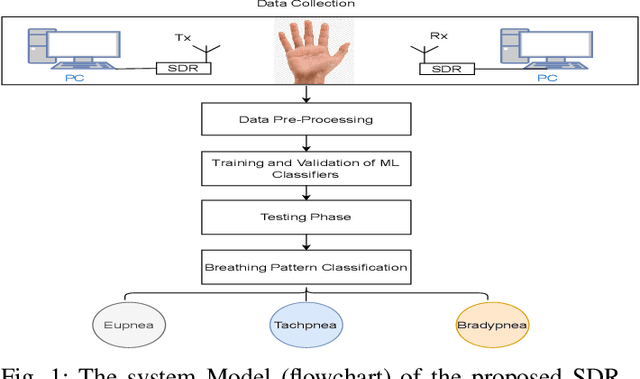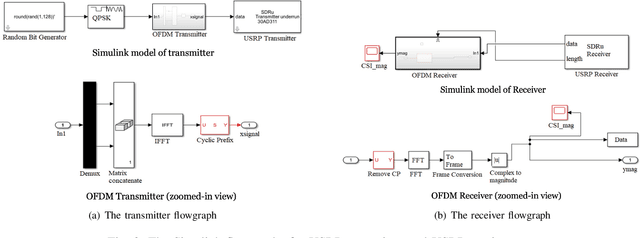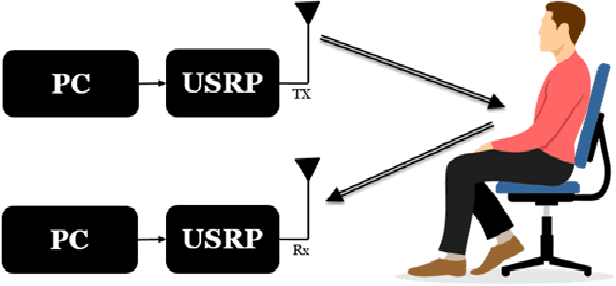Kawish Pervez
Non-Contact Monitoring of Dehydration using RF Data Collected off the Chest and the Hand
Jun 16, 2023Abstract:We report a novel non-contact method for dehydration monitoring. We utilize a transmit software defined radio (SDR) that impinges a wideband radio frequency (RF) signal (of frequency 5.23 GHz) onto either the chest or the hand of a subject who sits nearby. Further, another SDR in the closed vicinity collects the RF signals reflected off the chest (or passed through the hand) of the subject. Note that the two SDRs exchange orthogonal frequency division multiplexing (OFDM) signal, whose individual subcarriers get modulated once it reflects off (passes through) the chest (the hand) of the subject. This way, the signal collected by the receive SDR consists of channel frequency response (CFR) that captures the variation in the blood osmolality due to dehydration. The received raw CFR data is then passed through a handful of machine learning (ML) classifiers which once trained, output the classification result (i.e., whether a subject is hydrated or dehydrated). For the purpose of training our ML classifiers, we have constructed our custom HCDDM-RF-5 dataset by collecting data from 5 Muslim subjects (before and after sunset) who were fasting during the month of Ramadan. Specifically, we have implemented and tested the following ML classifiers (and their variants): K-nearest neighbour (KNN), support vector machine (SVM), decision tree (DT), ensemble classifier, and neural network classifier. Among all the classifiers, the neural network classifier acheived the best classification accuracy, i.e., an accuracy of 93.8% for the proposed CBDM method, and an accuracy of 96.15% for the proposed HBDM method. Compared to prior work where the reported accuracy is 97.83%, our proposed non-contact method is slightly inferior (as we report a maximum accuracy of 96.15%); nevertheless, the advantages of our non-contact dehydration method speak for themselves.
Hand-breathe: Non-Contact Monitoring of Breathing Abnormalities from Hand Palm
Dec 12, 2022



Abstract:In post-covid19 world, radio frequency (RF)-based non-contact methods, e.g., software-defined radios (SDR)-based methods have emerged as promising candidates for intelligent remote sensing of human vitals, and could help in containment of contagious viruses like covid19. To this end, this work utilizes the universal software radio peripherals (USRP)-based SDRs along with classical machine learning (ML) methods to design a non-contact method to monitor different breathing abnormalities. Under our proposed method, a subject rests his/her hand on a table in between the transmit and receive antennas, while an orthogonal frequency division multiplexing (OFDM) signal passes through the hand. Subsequently, the receiver extracts the channel frequency response (basically, fine-grained wireless channel state information), and feeds it to various ML algorithms which eventually classify between different breathing abnormalities. Among all classifiers, linear SVM classifier resulted in a maximum accuracy of 88.1\%. To train the ML classifiers in a supervised manner, data was collected by doing real-time experiments on 4 subjects in a lab environment. For label generation purpose, the breathing of the subjects was classified into three classes: normal, fast, and slow breathing. Furthermore, in addition to our proposed method (where only a hand is exposed to RF signals), we also implemented and tested the state-of-the-art method (where full chest is exposed to RF radiation). The performance comparison of the two methods reveals a trade-off, i.e., the accuracy of our proposed method is slightly inferior but our method results in minimal body exposure to RF radiation, compared to the benchmark method.
 Add to Chrome
Add to Chrome Add to Firefox
Add to Firefox Add to Edge
Add to Edge